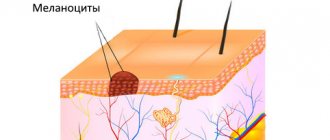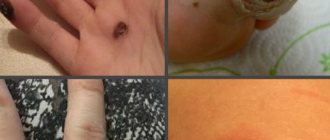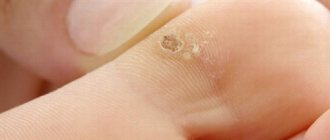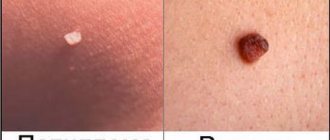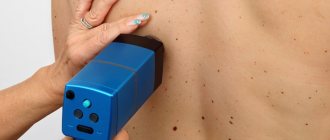The operating principle of the device: an electrode is constructed from thin wire. It converts electrical current into high frequency waves. Radio wave surgery uses electromagnetic waves of 2.7-4.0 MHz as a knife. In this case, the cutting effect is achieved due to the heat that is generated in the tissues when the electrode transmitting high-frequency waves comes into contact with the skin or other soft tissues. Heat is generated due to the resistance of tissues to radio waves directed at them. High-frequency energy accumulates at the end of the electrode, causing a rise in intracellular molecular energy, which heats the tissue. Cells located in the path of the radio wave “evaporate”, and neighboring tissues move apart without heating or burning. In this case, there is no direct contact of the electrode with the papilloma.
Advantages of radio wave removal of papillomas:
- Full control over the area and depth of radio waves;
- The surgical field remains almost bloodless due to coagulation (“sealing”) of small arterioles;
- The incision is made without direct contact with the skin, physical impact on the upper layers and mechanical damage to cells is eliminated;
- There is no charring of tissues and no black scab is formed;
- There is no excessive release of wound contents;
- Tissue dissection occurs quite easily;
- It is possible to remove tumors that protrude significantly above the surface of the skin and have clearly defined boundaries;
- The surgical intervention occurs very quickly (no more than 30 minutes);
- Swelling and infiltration at the postoperative stage are formed in a minimal amount;
- Pain syndrome during and after surgery is less pronounced, since radio waves cause coagulation of nerve endings and eliminate muscle spasms, as a result of which there is no effect on sensory receptors;
- The postoperative period is significantly reduced due to the acceleration of tissue healing (a fibrin film appears in the area of the operation and the wound healing process is accelerated);
- The postoperative wound heals by primary intention, as a result of which there is no rough scar (due to the fact that the papillomas are not excised, but cut off without affecting the surrounding healthy tissue);
- The radio wave has a sterilization effect (the wound surface is completely disinfected, all pathogenic microflora are killed, and as a result, there are no postoperative complications in the form of inflammatory reactions and swelling, no pus deposits);
- For histological examination for the presence of skin cancer, it becomes possible to take a better sample;
- Preservation of the shape of the organ surface;
- It is possible to carry out the procedure in outpatient settings;
- It is possible to remove tumors of any location (for example, it is quite difficult to remove papilloma on the eyelid - the surgical method is not applicable due to the close location of the eyeball, the laser can affect the organ of vision);
- High efficiency of radio wave removal of papillomas (the effectiveness of removing papillomas using radio waves is about 80-90%, and the probability of reappearance is 2-5%).
How is condylomas removed using the radio wave method?
During the manipulation, the patient is in a horizontal position. The doctor anesthetizes the surgical field (applies a cream with an anesthetic effect or makes an injection at the base of the papilloma, or irrigates with a special aerosol). After this, a radio wave scalpel penetrates the skin to the required depth, makes an incision of the required size and cuts off the papilloma completely. Small wounds appear at this place. The excised tissues are sent for histological examination. Radio wave removal of papillomas (surgitron) takes only a few minutes. After the operation is completed, the patient goes home. There is no need for daily examinations by the surgeon; wound care is carried out by the patient himself. You need to know what to pay attention to in order to avoid complications in the future.
Why are condylomas dangerous in men and women?
In women and men, condylomas stimulate the appearance of cancer of the cervix, penis, vulva, vagina and anal canal. Yes, those viruses that are responsible for the appearance of condylomas have a lower oncogenic potential. Than those that do not cause condylomas, but multiply asymptomatically, leading to the appearance of cancer. When there are many condylomas, they constantly grow and become injured. And the likelihood of cancer also increases. Of course, we should not forget about the possibility of infecting a partner with the same prospects in the future. During pregnancy, genital warts can cause a variety of problems from sudden growth to cancer.
Sign up for a consultation
Wound care after radio wave removal of condylomas
The wound after radio wave removal of papillomas does not have dead tissue - nutrient material for microbes; its suppuration is extremely unlikely. In this regard, the most preferable method for her is moist healing, which does not allow the wound to dry out and form a crust. Healing with the wet method proceeds much faster, and the scars are less noticeable. To do this, smear the wound with argosulfan or baneocin ointment 2-3 times a day, and seal the top with an air-tight plaster. However, there are still many doctors who are adherents of the old school. They recommend that patients, after removing papilloma using the radio wave method, treat the wound with potassium permanganate, calendula tincture, and brilliant green. This impairs healing results.
Features of wound care after removal of papilloma using the radio wave method
- During the first days, it is necessary to carefully monitor the postoperative wound (carefully palpate to exclude compaction, and also examine to control the color of the skin and the shape of its surface);
- Very carefully treat the postoperative surface with a soap solution at room temperature;
- If a crust has nevertheless formed, it should not be forcibly removed, as this will once again damage the wound and the healing process will slow down;
- Be sure to take a shower or bath;
- Avoid contact with cosmetics;
- Avoid visiting a bathhouse, sauna, or swimming pool, since a wet wound after removal with surgitron serves as an entrance gate for blood-borne viruses (hepatitis B, C, HIV);
- Avoid sunbathing and visiting the solarium until the wound is completely healed; if necessary, stay outside; the wound after removing the papilloma using the radio wave method should be protected from sun exposure;
- Avoid general physical activity, and do not subject the wound after radio wave removal to physical pressure;
- Drink enough water;
- If discomfort occurs in the area exposed to radio waves, you should immediately consult a doctor for advice.
After a few days, the wound heals, and renewed pink skin becomes visible. Gradually over the course of two months it will lighten, and in the future there will be no trace of the papilloma that existed in this place.
The process of radio wave removal of papillomas does not have negative consequences. There is only one known drawback to the use of radio waves - the inability to remove very large papillomas.
Contraindications to removal of papillomas with Surgitron
- Pulmonary and cardiac types of failure in the decompensated stage;
- Acute infections, fever;
- Chronic hepatitis with liver failure;
- Decompensated diabetes mellitus;
- Glaucoma;
- Epilepsy;
- Oncological diseases in the active stage;
- The patient has an artificial heart pacemaker;
- Inflammatory processes of the skin;
- Viral skin diseases;
- Pregnancy and lactation period;
- Menstruation;
- Any disease in the acute stage.
Laser cauterization
The difference between removing papillomas using the radio wave method and laser removal is that when using the latter, it is quite difficult to accurately control the depth of penetration. Consequently, there is a high probability of burns of adjacent undamaged tissues. As a result, the wound healing period increases. There is also the possibility of incomplete removal of the papilloma, which in the future threatens relapse and the appearance of cosmetic defects in many patients after surgery.
Some laser devices are more complex in design and more expensive than radio wave surgery equipment, which is why the cost of removing papillomas using a laser is sometimes higher than the cost of removal using the radio wave method. When using the laser method, it is not possible to take samples of the tumor for histological analysis, since this procedure involves evaporation and burning of the problem area of the skin. Another disadvantage of using a laser device is that if the settings are incorrect and the pain threshold is high, pain is felt. And before the operation, the patient needs to take a painkiller or get an injection. In the case of radio wave removal of papillomas, the zone of coagulation necrosis (necrosis) surrounding the tissue dissection site is ten times smaller than when using a laser. Which leads to less scarring and faster healing.
Features of interventions carried out using a radio knife "Fotek - EHHF-80"
Preparation for procedures using Fotek equipment includes: gynecological examination and a series of tests that will eliminate any unpleasant surprises during and after the operation.
As before any intervention, a woman must undergo:
- colposcopy - a routine gynecological examination using an optical colposcope device, which improves the visibility of pathologies - is performed by our gynecologist;
- cytological smear for atypia - detection of cancerous and precancerous cells (valid for 6 months) - taken by the gynecologist during the examination;
- smear for microbiocenosis to detect infections and STIs (valid for 2 weeks) - taken at the appointment;
- a blood test for a number of infections - syphilis, hepatitis (valid for 3 months) - can be taken in our laboratory;
- PCR analysis for 9 main infections is also performed in our laboratory.
Almost all interventions performed with modern radio wave equipment, taking into account preparation, take an average of 10-15 minutes. Women who choose this method do not face any discomfort or pain. The absence of complications in the form of scars is guaranteed.
After the procedure, the gynecologist will give recommendations that you will need to follow. After a month, it is recommended to undergo a follow-up examination to make sure there are no complications.
Electrocoagulation
Electrocoagulation is a method of removing papillomas using high thermal effects, which damages the tissue around the tumor. During the procedure, pain is more intense than during radio wave removal, and even laser. Healthy tissues are actively involved in the course of the operation, becoming a source for the formation of rough scars. Unlike radio wave removal, with electrocoagulation it is not possible to take a full sample for histological examination. Another disadvantage is that only small papillomas can be removed using current.
Advantages of surgical treatment of bartholinitis with radio waves
The radio wave knife “Fotek” is a modern tool for treating diseases of the female genital area. It is used to open a Bartholin gland abscess and to remove a cyst (by decision of the gynecologist).
Advantages of the method in the treatment of bartholinitis:
- effect of local anesthesia;
- reduction of blood loss;
- no tissue damage;
- excellent cosmetic effect (no scar complications);
- almost zero percentage of complications;
- accelerated healing;
- minimal number of contraindications;
- reduction of surgical intervention time to 10-15 minutes.
Another innovative treatment that is gaining popularity in the field of gynecology is the surgical CO2 laser. According to the doctor’s decision, this method is used to remove cysts, open a Bartholin gland abscess and perform other gynecological procedures. Its advantages:
- excellent cosmetic effect (no scars);
- full control of the depth of exposure (prevention of bleeding);
- high speed of impact;
- minimizing the relapse rate.
Both methods are available at the Diana Clinic, but as mentioned above, the decision on the choice of treatment is made by the doctor. The specialist relies on diagnostic results, indications and contraindications; important characteristics are the degree and depth of the process.
Liquid nitrogen removal
Cryodestruction is the removal of papillomas using liquid nitrogen. The main property of this method is that with its use you can get rid of tumors of any size and shape. After the papilloma cells are rejected, a framework of skin fibers remains, making the scars more accurate. This is practically the only method in which it becomes possible to remove large damaged areas. Immediately after cryodestruction, swelling and blisters form in the area of papillomas. The radio wave method has the advantage of faster healing and a cleaner appearance of the wound itself during healing. In addition, during cryodestruction it is not possible to take a biopsy; this must be done before the procedure.
Attention!
This article is posted for informational purposes only and under no circumstances constitutes scientific material or medical advice and should not serve as a substitute for an in-person consultation with a professional physician.
For diagnostics, diagnosis and treatment, contact qualified doctors! Number of reads: 3283 Date of publication: 09/04/2018
Dermatologists - search service and appointment with dermatologists in Moscow
About the FOTEK device we use
Electrosurgical high-frequency radio wave knife is used in cosmetology, dermatology, gynecology, urology and other fields of medicine. Model EHVCh-80-03 FOTEK is designed for targeted interventions, each type of operation is performed with a special attachment included in the kit:
Areas of use of FOTEK -
EHHF-80 :
- low-traumatic endoscopic operations;
- ophthalmological and ENT interventions;
- laparoscopic procedures;
- plastic surgery in dermatology;
- dentistry;
- aesthetic cosmetology.
The electrosurgical radio wave device operates in the following modes:
- Non-contact radio knife
. A monopolar incision is made. Ideal for tissue sampling using biopsy for further research. The tissues do not overheat and are not injured. - M-polar cutting with cauterization
(soldering, coagulation) of tissues. Reduces blood loss and postoperative pain. - Mono coagulation.
Slow m-polar cauterization. A gentle effect that reduces the likelihood of coagulant rejection and, accordingly, blood loss. The gynecologist can regulate the time and depth of exposure. - Non-contact m-polar coagulation.
Used for sealing capillary vessels and removing fat. - B-polar coagulation
. With limitation of the impact area, which is especially important during operations on delicate tissues in ENT practice, when operating in the spinal cord area, etc. - Bi-polar cutting with coagulation
. The doctor receives a neat cut thanks to the minimum contact area (the thinnest tweezers or knife). The radio pulse penetrates a limited area without affecting healthy tissue.

